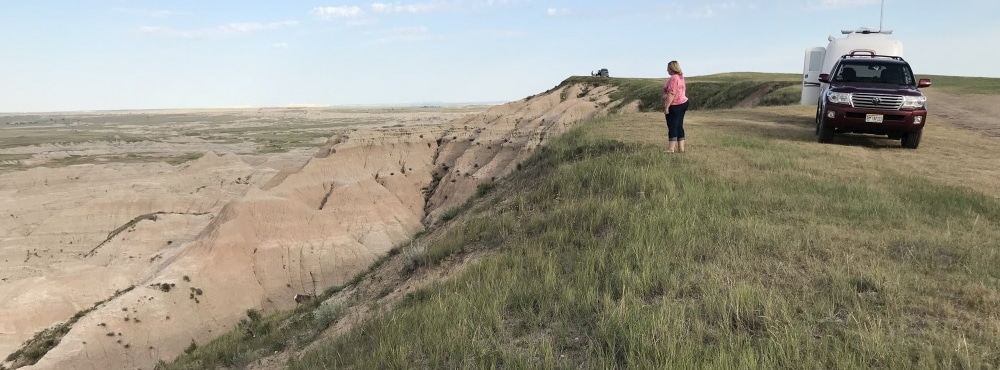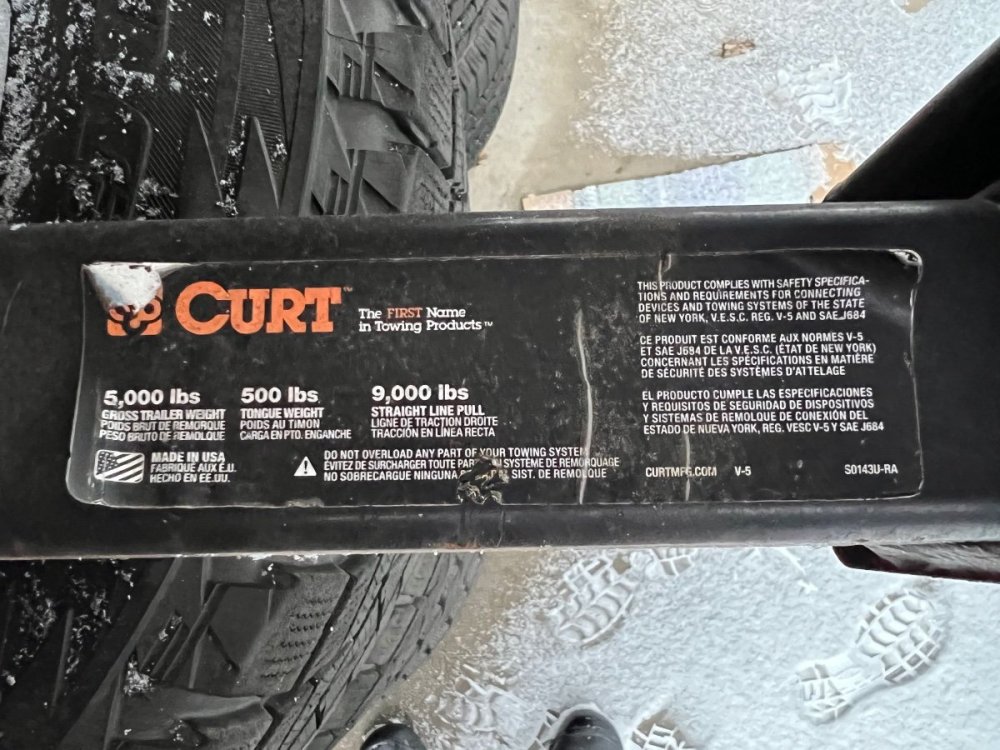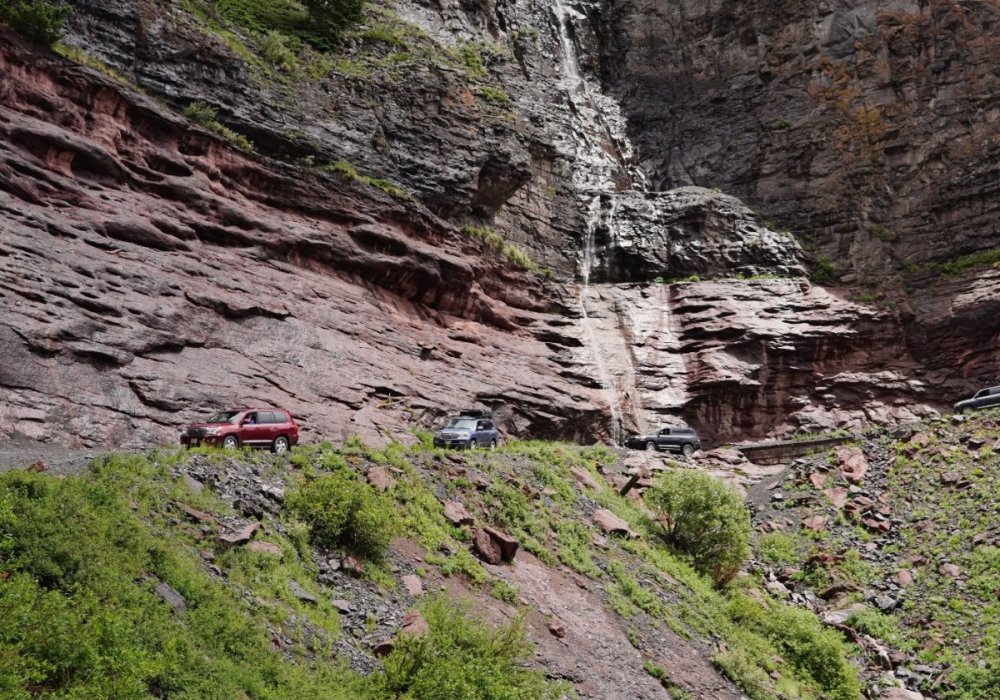-
Posts
113 -
Joined
-
Last visited
-
Days Won
6
Everything posted by KenB
-
There are more Mn state parks open for the winter than I thought. Make sure you make reservations in advance. https://www.dnr.state.mn.us/state_parks/winter_camping.html Ken
-
I live in the Mpls/StPaul area in Minnesota and have driven our LE II to Utah/Colorado and back in March (and in the summer). Everything is weather dependent. A pretty major winter storm moved across Nebraska when we made the trip west. We dropped down to Kansas to avoid it. It added a 1/2 day of additional travel. I70 west of Denver closed for a few hours the next day due to an avalanche. Not a big deal to sit out a road closer when towing a camper (you have food, water, heat, and a toilet), but it could have been bad depending on plans and reservations. Don’t plan on covering summer travel distances in the winter. The truck stops and rest areas are always jammed full with semi rigs between here and Denver. You can’t depend on them being accessible for even an hour or two of rest. Rigs are often parked up and down solid in the access lanes. It took five summers of traveling, but I’ve been to every state park in Minnesota. While open for day visitors, most close the gates to the campgrounds around mid October and don’t open again until Spring. The Mn DNR has a good website where you can make reservations. Check it out before assuming they’re open. Mn state parks require online reservations now. Ranger stations will be unmanned in the winter, except MAYBE weekends. Cell service isn’t guaranteed. You may end up backtracking many miles to pick up a signal to claim a campsite even IF you find an open park. The days of filling out a slip and dropping your fee in the box on the post are mostly over. I know that many of the National Forest campgrounds around Ely are also closed during the winter. It’s probably not worth it to plow out the snow, especially in the camping spurs. The Army Corp of Engineers close their campgrounds too. Even in early October I have most campgrounds to myself. Call the ranger district for the area of the BWCA that you plan to visit, it’s pretty slow up there in the winter, they should have time to talk. They’d have a list if there are any camping options. Unless you’re driving freeway, stick to daylight hours anyplace north of St Paul due to deer strikes. At least the rut will be over when you’ll be here. Hwy 35 from Iowa to Duluth will be well taken care of. Same for Hwys 61 and 53 north out of the Duluth area and towards the BWCA. Expect side roads off of 35/53/61 to be slippery and ice covered. It’ll be a pleasant surprise if they’re not. I’ve never seen anyone use chains in Mn. Studded tires are illegal for residents. Everything east of Duluth over to Sault Ste. Marie, MI is pretty desolate. You’ll probably take highway 2 east out of Superior, WI after heading south out of the BWCA. It’s a two lane state highway. Don’t assume gas stations will be open late. LOTS of deer on that road. I haven’t been east of The Soo at all, so I can say what it looks past there. I’ve driven my motorcycle around Lake Superior in the summer. I would not want to tow my camper around it in the winter. No driving up there after dark. If a storm comes through, it can be hours before a tow truck is available. They might have to come from a considerable distance and will be backed up. Plan on spending the night in the ditch if you go off the road late in the day. Cell service is spotty away from the freeway in MN, WI and in the UP. It seems to switch between Verizon and AT&T depending where you are. If I was making the trip, I’d lean heavily on our Harvest Host subscription. It’s more likely a business would have a place for you to park compared to public camping facilities. Hope this helps. It can get VERY cold. I used to live in Duluth. It can be below 0° for weeks, especially as you go north. Let me know if you need anything else. Good Luck and be flexible.
-
The attached photo is the only markings on the hitch. In order to make it fit, you’ll need to trim a little of the plastic around the front recovery points. DON'T drive off-road with this particular hitch in place. It rides too low. On pavement it’d barely be okay. I forgot it was there when going down a logging road once while bird hunting. I came over a rise that quickly dropped down into a deep hole on the other side. The front hitch caught the far edge of the hole and face planted the whole rig. The guns, gear, and hot coffee from friends in the backseat all ended up in the front seat. A couple of dollars at the car wash and a high pressure hose wasn’t enough to clean up the muddy mess under the truck. I had to put it on a lift at work and remove all the front skid plates to clean out all of the impacted mud. Fortunately nothing was bent or broke. This past year I came into a small three cylinder diesel tractor with a front end loader. It’s got a spot for a hitch ball on the edge of the bucket. I’m going to use the tractor, bucket, and ball to place the trailer in its tight winter resting spot under the back garage car port once I quit ruffed grouse hunting in a few weeks. With the super short wheelbase, it should make it even easier than the front hitch on the Land Cruiser.
-
My furnace short cycled. The furnace blinked out a trouble code that said something like 'blocked discharge vent'. I popped all the grills off of the heat registers and ran the furnace again. No more codes and no more short cycling. I then put the grills back on while being very sure the adjustable dampeners were in the wide open position. Again no codes and no short cycling. Mine doesn’t click from the air conditioner, so yours is probably something else. It doesn’t cost anything to pull the heat register covers and give it a try though. BTW-The outside cover to my furnace is translucent white plastic. If it’s dark out you can see the red LED on the control board blink out its trouble code through the white plastic without oven taking the outside cover off. I caught the blinking codes by accident while walking around the camper in the dark. Good Luck.
-
I had a base model Parkit360, not the same as the Trailer Vallet EX, but similar. Wouldn’t come close to working in my situation. Next I bought a front mount hitch for our Land Cruiser and was much more happy with the arrangement. Very maneuverable with the steering wheels being so close to the hitch. And much less expensive than any of the mechanical or electric trailer movers. Consider a front mount hitch, it mounts with just four bolts and other than the weight, it unbolts when you don’t need it pretty easily.
-
Thank for the late night comment John. You’re right. My mental math with Volts, Watts, and Amps was off by a decimal place this evening. The onboard converter is the way to go.
-
Very timely. Thanks for asking the question. I’m dealing with battery problems today too. This evening I drove 150 miles up to our rural property where we keep the Oliver most of the summer and fall. There isn’t electric power on the property anymore, so it’s off grid camping when we’re here. First thing I notice when I drive up to the camper in the dark is that the outside porch lights were left on for at least a week, 24 hrs/day. That was my mistake. Leaving the lights on was compounded by overcast skies with rain and snow all week keeping solar production way down. After unlocking the door and turning on the interior lights, I see the battery voltage is down to a cringeworthy 11.0V. Once I turned on the furnace, the battery Voltage dropped to somewhere around 10.4V! I realize that now I have an urgent problem. If I don’t get some additional power to the batteries in the next few hours, I’m not going to be able to run the furnace tonight, and then I’m going to be dealing with frozen pipes tomorrow. Luckily last week I bought a 1000W Yamaha RV type generator at a garage sale, so now I’m listening to generator noise while charging the batteries and running the furnace so the pipes don’t freeze tonight. Surprisingly, the little 1000 Watt Yamaha generator puts out the same 8A@12V DC for battery charging as our big 5000W Honda generator. Of course the Honda puts out much more AC power, but it’s puzzling as to why their DC power output rating is equal. The new generator has been running for about two hours now and the battery shows 13.2V. I’ll probably go fuel it up again before bed and just let it run. We don’t have any neighbors to worry about. Our factory solar panels with healthy batteries should have handled leaving a few lights on for the week, overcast or not. Now I’m shopping for new batteries too.
-

Dometic Gas Stove doesn't ignite
KenB replied to Citrus breeze's topic in Mechanical & Technical Tips
I agree with following up with this. I also agree with this. Please add your info to your signature or to your post. -

Dometic Gas Stove doesn't ignite
KenB replied to Citrus breeze's topic in Mechanical & Technical Tips
Please do not jam a paper clip into a precision brass orifice, carefully or otherwise. You’ll create additional problems for yourself, likely expensive. If you decide this is necessary (unlikely on a newer trailer), you’ll need a probe softer than the brass jet, think more like broom straw, brush bristle, or my favorite, a single strand from a multi strand copper wire. I’ve cleaned dozens (hundreds?) of jets on small engines and RV appliances. Please don’t ruin your jet by ‘cleaning’ it with a paperclip. -
It’s easy to forget the 110 switch for the electric heating element on the water heater. Is that turned on? I’ve made that mistake myself.
-

How do you get local weather while Boondocking and no Am or Fm reception.
KenB replied to MarkC's topic in General Discussion
Though I’ve owned my own ham radio receivers since Junior High School, I didn’t have a license until three years ago. My wife and I went on a group Land Cruiser 4x4 trip in the Colorado mountains around Ouray that required 2M communication, so I got my Technician and a hand held Kenwood radio. FRS only reaches so far. I should have taken the General test at the same time. An engineering undergrad degree and 20 years of teaching high school shop class made the Technician exam pretty painless. That was the end of my recent radio experience, so you could say that I’m not very active. Thanks for the kind words. Ken KE0VTG -
-
I’m going to say maybe on the top rain-flap. Last weekend I went shopping and bought a second clam brand screen tent. We already have a Pavilion model. It’s huge and not all that convenient to set up, move, or store. Super nice if we stay someplace for a week or so. It has room for the picnic table, a couple of chairs, and keeps the dogs confined. The rain panels are built in (they roll down and Velcro on place) with the Pavilion model. With the latest purchase I went with their Traveler model, their smallest screen tent. It’s 20# and I’ve read it’ll fit in the Oliver’s closet. I have to tie the Pavilion to the roof of our Land Cruiser. The Traveler is offered in two colors, brown or green. While trying to determine if there were any other differences I studied the boxes closely. The photo on the brown tent’s box clearly showed a rain flap, the green one clearly did not. I did not study the tents themselves, only the photos on the boxes. I vaguely remember this also being true a few years ago when shopping for our original Clam screen tent. The brown ones had rain flaps, the green ones did not. Early in this thread others commented about heat inside a Clam screen tent being a problem. I agree with that. It can get hot. When I was looking at Clam tents last week the retailer had a new model demo Clam tent set up with a screen ceiling. Not sure about the durability, but it sure was bright and cool inside with the screen ceiling. I think it’s a good idea. It was a medium sized version, so not what I was looking for. hth, Ken
-
We just used Harvest hosts on our drive from Minnesota to Colorado and back last week. We used it five nights total. There are breweries and wineries right off the interstate that are popular and you’ll need to reserve ahead at least a week. Others attractions are available on short notice, especially if they are less popular and further off the interstate. If you travel on state highways during the week, no problem. If you only travel on interstate highway on the weekend, expect to plan ahead at least a few days. Needing to plan ahead months in advance wasn’t my experience.
-

How do you get local weather while Boondocking and no Am or Fm reception.
KenB replied to MarkC's topic in General Discussion
The OP should do this too. Here is a map of the coverage. https://www.weather.gov/media/nwr/NWR_Propagation.pdf Here is a description of the weather radio service, a service provided by NOAA. https://www.weather.gov/nwr/ Here is a description of NOAA as a whole. https://www.weather.gov Most of the time I just use my cell phone for a weather report, but other times I use the weather radio, my shortwave receiver, or my 2M handheld, all are pretuned to the NOAA frequencies. The NOAA is the primary source of weather information in the country and is broadcast everywhere. Local forecasts are included. -
I guess I’m confused as to why you’d want to remove a working unit. My Elite II was delivered with a defective refrigerator at initial factory pickup. In order to replace the defective unit the whole door frame had to be removed so they could make the swap. The refrigerator unit is bigger than the door frame, but smaller than the door opening. It’s a major undertaking to get the refrigerator out and onto the bench in the shop for a likely unneeded service. Nothing else to add other than be ready to remove the whole door frame or be ready to service on the dinette. Ken
-
I work on a lot of small engines and motorcycles professionally and as a hobby. Here in Minnesota they get stored for an extended period annually. The number #1 reason they won’t run in the spring is a gummed up carburetor due to evaporated gasoline, especially ethanol. If you’re a non mechanic, consider sinking $20-$30 on a brand new carburetor. They’re cheap on Amazon, eBay, and small engine sites. You’ll spend hours unsuccessful attempting to clean/test/clean/test your old carb and you’ll still end up buying a new one. I have an ultrasonic cleaning bath, chemicals, tools, and experience and I spend very little time cleaning carbs anymore because the new ones just bolt right on and off the engine fires. Take lots of pictures of the linkage routing. Unbolt the old carb, bolt on the new one. It’s going to take longer to find which one to order than actually replace it. HTH. Ken
-
I’ve got the same image with my wife and I in our 2013 Land Cruiser! We’re in the red one on the left side of the photo. Also drove the Million Dollar Highway with the E II. Wouldn’t have been too bad except when a diesel pusher took up some of my lane while going around a corner. Thought he was going to force us into a rock overhang.
-
In addition to cold air, plan on mosquitoes too. I was up late one night trying to find where they were coming in when I noticed one fly out from behind the refrigerator face trim plate. I taped up the opening inside, swatted the rest of her buddies, then went back to bed. Next day I pulled the outside refrigerator cover off and found a bunch of the foil tape had come off in the heat. It’s not only cold air that can blow in through the openings. Bugs will be attracted to the heat and refrigerator combustion gases and eventually end up inside with you too.
-
It’s not a leak, it’s condensation. The area of condensation is roughly in the profile of a body. I’ve tracked down leaks that landed under the mattress before. It’s not that. Last night was another data point. No rain. Indoor recording thermometer registered a low of 67 degrees inside the camper. Roof vent running on low all night. Fan on night stand running on medium all night. The window next to the bed wide open. Blinds open. Dinette window wide open. I slept in the street side bed. There was condensation under my mattress this morning. I’m certain that if I moved to the curb site mattress tonight I’d have condensation under that mattress on that side instead. It’s not a leak. We used to have a hybrid camper with tip out bunks on the end. With nothing but cool air under the bunks when set up, that setup was a condensation capturing machine. The Oliver comparatively captures a fraction of the condensation. My point is that even the standard cushions will allow condensation to form under them nearly year round for me. It’s not limited to the latex mattresses. Ours are the standard cushions. HTH, Ken
-
I have the standard mattress with a topper over it and have problems with condensation underneath. It's not just restricted to latex mattresses. Minnesota fall camping is worst for under mattress condensation, but it can occur anytime when the conditions are right. Cool hull and several blankets on top of me holding in moisture seem to make it most likely to occur. When I'm solo I sleep on the curbside of our twin bed E2. The water heater and furnace (if its cool enough to run it) under the bed keep the fiberglass under the mattress warm enough to keep the condensation under control. Water has condensed on the wall a few times next to me while sleeping, but nothing like the regular condensation I get under the mattress. Update- Just went out and lifted the mattress after camping last night. There is condensation underneath. Temps were in the high 60's-low70's Roof vent fan was running on low all night. One window cracked. One light blanket half on me. Top and bottom sheet. Rained yesterday afternoon. I need to put an old camping mat under the mattress and give that a try. So it's not just the latex mattresses. My 2018 also has regular issues.
-
Here is the board I used. There are two styles of this board; one with a blade connector for the igniter, and one with a stud connector for the igniter. For my 2018 I got the one with the blade. They are available from many suppliers, including Amazon. HTH, Ken (Out camping right now. Enjoyed a warm shower just this morning.)
-
Last season our Suburban water heater didn't always light on the first try, or even second. Once from inside I heard it light with a startlingly loud WOOF! Not good. On the second trip this season it quit working altogether. This past week I started troubleshooting and found that they aren't that hard to work on. This is what I found. I checked the gas supply by trying the stove and furnace. Both worked, so it's not a gas supply issue. Watched and listened for the gas valve to open and the igniter to cycle. I could hear at least one of the gas valves clunk open and could see the igniter try to spark. I pulled the orifice and orifice tube expecting to find a spider web or mud dauber nest like I did in a previous camper's refrigerator. All clean, so not the issue. There is a high and low temp cut off switch. Neither was tripped. I don't believe the water heater will cycle the ignition circuit if either are faulty or tripped. Mine was still trying to light, so I didn't think this was the issue. On-line reading said to suspect the coils on the gas valve. There are two side-by-side. Both need to open. They are redundant for safety. A local RV/Propane service shop gave me some used coils out of their junk box to try. Swapped out the coils. Still didn't work, coils were not the issue. Early on I should have tried lighting the gas coming out of the orifice tube with a camp butane lighter as the furnace went through its ignition cycle. Finally did. Lit just fine. This would have eliminated any issues with the gas valve, coils, orifice, and orifice tube from my trouble shooting. Learn from my mistake and don't jump ahead too fast. By now I notice a weak to non-existent spark. Early on I thought it might be weak, but now it's not even present. I now believe the spark got weaker as the ignition board warmed up during testing and cycling. All that was left in the ignition circuit to eliminate was the spark igniter and the igniter circuit board. I ordered a both spark igniter and a Dinosaur Igniter board (Model # UIB S w/spade connector) off of Amazon. Since it was the least expensive and the easiest to get at, I Installed the new spark igniter first. Still no love. Unplugged old board, plugged in the new Dinosaur board, turned on the heater switch, the water heater fired right up. The igniter board was bad. Old board wasn't hot, but was warmer than expected. One of the traces on the old board looked a little warm around one of the transistors. I'll have to look it over under a magnifying glass when I get a chance. Might be good for a spare if I can fix it. The existing cover won't fit over the new Dinosaur board. Dinosaur sells their own cover to fit their own boards. I'll put one on my shopping list for someday. The old board was held in with double stick tape. The new board is now in place with some VHB tape I had on hand. That's it. These aren't too complicated. Though I wasn't interested in scheduling an appointment, the local RV service center was booked 6 weeks out. Minnesota summers are short and I enjoy hot water in the camper. Maybe this will help someone else troubleshoot and save a trip to the service center. Ken (Safety disclaimer - Follow at your own risk. Beware of gas, high voltage from the igniter circuit, sharp edges on the water heater sheet metal, and the pointy end of the screwdriver.)
-
Tractor Supply zerk shopping tip: Zerks are packaged in smaller quantities and are more expensive per piece in the tractor parts section at Tractor Supply. Zerks in the Hardware or Autos section of the same store have more per package and cost less per piece. Probably a made in USA vs made elsewhere issue. Quality may or may not follow price. I replaced most of my straight ones with angled zerks. Much better for avoiding contortions under the trailer.









